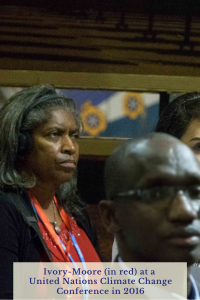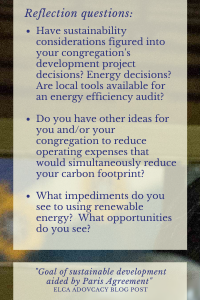By Ruth Ivory-Moore, ELCA Program Director for Environment and Corporate Social Responsibility
President Biden’s decision to re-join the Paris Agreement cannot be overstated in its importance for the United States and internationally. The detrimental effects of climate change resulting from global warming impact every corner of the world, impacting all sectors, putting a strain on existing social, environmental, health and economic systems, and negatively impacting sustainable development in every country.
“Instead of being stewards who care for the long-term wellbeing of creation, we confess that we have depleted non-renewable resources, eroded topsoil, and polluted the air, ground, and water. Without appropriate environmental care, economic growth cannot be sustained” from the ELCA social statement Sufficient, Sustainable Livelihood for All (p. 15).
In Caring for Creation: Vision, Hope, and Justice, the ELCA social statement reads, “We of the Evangelical Lutheran Church in America are deeply concerned about the environment, locally and globally, as members of this church and as members of society” (p.1). The following shares some background about what the Paris Agreement (Agreement) involves. While the language of the document uses references like “civil society” and “NGOs,” it means “all hands on deck.” People of faith and our congregations and communities are invested in caring for creation, and we will demonstrate our concern locally as well as in policy advocacy to face changes needed to confront the trends bringing us to this climate crisis which our nation and world must address. “We see the despoiling of the environment as nothing less than the degradation of God’s gracious gift of creation” the statement continues (p. 2).
Aims of the Paris Agreement
 The Agreement is a product of the United Nations Convention on Climate Change (UNFCCC). For the first time in 2015, all nations came together “to undertake ambitious efforts to combat climate change and adapt to its effects, with enhanced support to assist developing countries… As such, it charts a new course in the global climate effort.” The Agreement strengthens the collective global effort to keep the global warming temperature below 2oC above pre-industrial levels. Global warming is causing significant environmental degradation. Climate change impacts lead to more severe and frequent weather patterns and melting ice caps resulting in sea level rise to increased flooding.
The Agreement is a product of the United Nations Convention on Climate Change (UNFCCC). For the first time in 2015, all nations came together “to undertake ambitious efforts to combat climate change and adapt to its effects, with enhanced support to assist developing countries… As such, it charts a new course in the global climate effort.” The Agreement strengthens the collective global effort to keep the global warming temperature below 2oC above pre-industrial levels. Global warming is causing significant environmental degradation. Climate change impacts lead to more severe and frequent weather patterns and melting ice caps resulting in sea level rise to increased flooding.
The Agreement aims for all countries to make commitments for reducing greenhouse gas emissions (mitigation), financial resources, reporting, and review to increase its commitment (ambition) to reduce greenhouse gas emissions. Transitioning the world economies to zero carbonization by 2050 is paramount under the Agreement and is essential for sustainable development. But as recent as 2018, the Intergovernmental Panel on Climate Change (IPCC) commissioned by the UNFCCC found that the temperature needs to be 1.5°C or lower through its research.
The year 2020 was to be a time under the Agreement when the U.S., along with other countries of the world, raised ambition to address climate change. That is, each country should have been increasing its commitments to reduce greenhouse gas emissions. But instead, the U.S. found itself withdrawing from this vital pledge.
Sustainable development aims
Sustainable development cannot occur until a transition to a net-zero carbon economy is a reality. The IPCC reported that “limiting global warming to 1.5°C would require rapid, far-reaching and unprecedented changes in all aspects of society.” Specifically, “Global net human-caused emissions of carbon dioxide (CO2) would need to fall by about 45 percent from 2010 levels by 2030, reaching ‘net zero’ around 2050.” This transition requires financial mechanisms and innovation in all sectors.
 For example, measures should be in place to address energy efficiency in buildings in all businesses and nonprofits and in residential facilities in addition to all equipment and appliances. This is one of the places our congregations can demonstrate mindfulness of the ripples of our decisions in the bigger picture. Implementing energy efficiency measures can help a congregation reduce its operating expenses as well as improve sustainability.
For example, measures should be in place to address energy efficiency in buildings in all businesses and nonprofits and in residential facilities in addition to all equipment and appliances. This is one of the places our congregations can demonstrate mindfulness of the ripples of our decisions in the bigger picture. Implementing energy efficiency measures can help a congregation reduce its operating expenses as well as improve sustainability.
For new construction, state and local governments should adopt construction codes that adhere to stringent energy codes. There should be a national just transition program that allows individual states and localities to develop their implementation plan to reach net-zero by 2050 without leaving anyone behind. The federal government should spur the transition to renewable energy by continuing with tax incentives. Congress should pass comprehensive infrastructure legislation that improves, revamps, and constructs new (where needed) electric transmission, distribution, and storage, providing for the necessary integration with state and local officials’ inclusion. Rural America must be included, focusing on broadband accessibility, and identifying agriculture sustainability. The incorporation of nature-based solutions is crucial.
A special responsibility
Human capital and participation are essential for reaching real sustainability. There must be urgent and assertive action by all to eradicate any barriers to participation, including but not limited to biases, whether race, gender, generational, or disability. Policy development must include diversity in participants and in disciplines such as impacted persons, lawmakers, civil society, and corporations, to name a few. Provisions and procedures must ensure that civil, environmental, and human rights are protected. Additionally, the U.S. must re-engage in the climate action process at home and globally. President Biden’s decision right after taking office to re-join the Agreement was a crucial step. The U.S. must be at the table leading and working alongside our international neighbors, for we are all interconnected and must be part of the solution.
The challenges are daunting. But we have inspiration, commitment and creativity. “God’s command to have dominion and subdue the earth is not a license to dominate and exploit. Human dominion (Genesis 1:28; Psalm 8), a special responsibility, should reflect God’s way of ruling as a shepherd king who takes the form of a servant (Philippians 2:7), wearing a crown of thorns” (p. 2-3).
